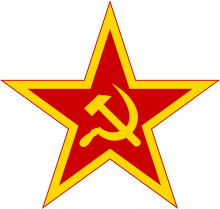
Back الجيش السوفيتي Arabic Sovet Ordusu Azerbaijani Совет Армияһы Bashkir Савецкая Армія Byelorussian Sovětská armáda Czech Sowjetarmee German Σοβιετικός Στρατός Greek Soveta armeo Esperanto Ejército Soviético Spanish Nõukogude armee Estonian
You can help expand this article with text translated from the corresponding article in Russian. (February 2014) Click [show] for important translation instructions.
|
| Soviet Army | |
|---|---|
| Советская армия | |
 Emblem of the Soviet Army | |
| Founded | 25 February 1946 |
| Disbanded | 14 February 1992 |
| Country |
|
| Type | Army |
| Role | Land warfare |
| Size |
|
| Nickname(s) | "Red Army" |
| Motto(s) | За нашу Советскую Родину! Za nashu Sovetskuyu Rodinu! "For our Soviet Motherland!" |
| Colors | Red and yellow |
| Equipment | |
| Engagements |
|
| Commanders | |
| Notable commanders | Georgy Zhukov |
The Ground Forces of the Armed Forces of the Soviet Union (Russian: сухопутные войска, tr. Sovetskiye sukhoputnye voyska)[2] was the land warfare service branch of the Soviet Armed Forces from 1946 to 1992. In English it was often referred to as the Soviet Army.[a]
Until 25 February 1946, it was known as the Red Army.[3] In Russian, the term armiya (army) was often used to cover the Strategic Rocket Forces first in traditional Soviet order of precedence; the Ground Forces, second; the Air Defence Forces, third, the Air Forces, fourth, and the Soviet Navy, fifth, among the branches of the Soviet Armed Forces as a whole.[4]
After the Soviet Union ceased to exist in December 1991, the Ground Forces remained under the command of the Commonwealth of Independent States until it was formally abolished on 14 February 1992. The Soviet Ground Forces were principally succeeded by the Ground Forces of the Russian Federation in Russian territory; beyond, many units and formations were taken over by the post-Soviet states; some were withdrawn to Russia, and some dissolved amid conflict, notably in the Caucasus.
- ^ a b International Institute for Strategic Studies 1991, p. 37.
- ^ Thomas, Nigel (20 January 2013). World War II Soviet Armed Forces (3): 1944–45. Bloomsbury Publishing. ISBN 978-1-84908-635-6.
- ^ Established by decree on 15 (28) January 1918 "to protect the population, territorial integrity and civil liberties in the territory of the Soviet state."
- ^ Suvorov 1982, p. 51.
Cite error: There are <ref group=lower-alpha> tags or {{efn}} templates on this page, but the references will not show without a {{reflist|group=lower-alpha}} template or {{notelist}} template (see the help page).
© MMXXIII Rich X Search. We shall prevail. All rights reserved. Rich X Search